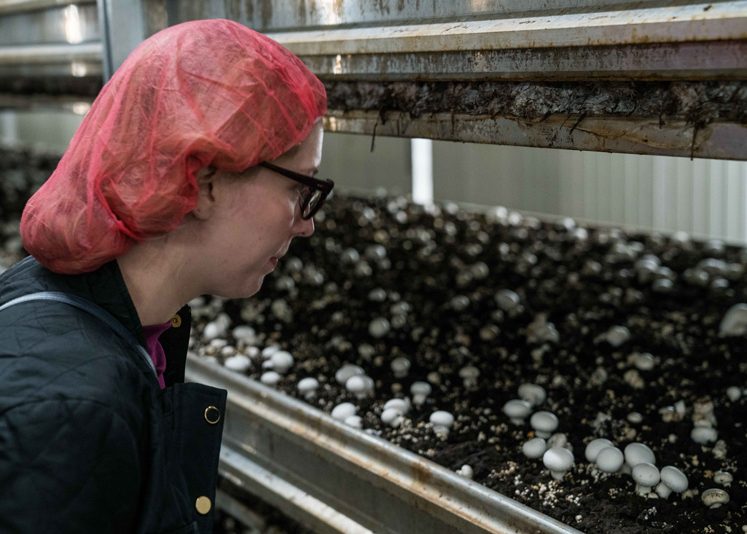

: youtube.com/watch?v=BvOoOM5k12A
Mushroom geography
Photo and video by Michael Graw March 23, 2018
UD grad student’s risk analysis contributes valuable information to industry leaders
Iowa has corn, Idaho has potatoes and, unbeknownst to many, Pennsylvania has mushrooms. Chester County, Pennsylvania, produces roughly 50 percent of all mushrooms grown in the United States. The top 50 growers in Chester County produced roughly 405 million pounds during the 2015-16 growing season, valued at approximately $391 million, according to a 2017 report from the USDA National Agricultural Statistics Service.
University of Delaware graduate student Samantha Speck has been studying the U.S. mushroom industry to identify the biggest risks facing the industry, through the lens of geography.
In particular, Speck’s research is about both perception of risk and analyzing how those affected are working to mitigate or prevent that risk. Plenty is known about mushrooms themselves: their nutritional properties, growing aspects, the pests and diseases, she said, but the industry’s risks are an untapped area.
“You look at politics, legislation, geography, cultural differences in the area, and you try to understand what is causing these risks through people’s perceptions and other perceptions—other lenses,” said Speck, who earned an undergraduate degree in geography and spent time as a professional risk analyst before pursuing her master’s degree in UD’s Department of Geography, which is housed in the College of Earth, Ocean, and Environment.

According to the Mushroom Growers of Pennsylvania, mushrooms have been grown in southeastern Pennsylvania for more than 120 years. It began as a cottage industry for a florist named William Swayne, who began growing mushrooms under benches in his greenhouse in the mid-1880s. He ultimately built the area’s first mushroom house, joined forces with his son and commercialized the effort into a thriving business. Others saw Swayne’s success and the industry in Chester County, well…mushroomed.
As part of her thesis research, Speck interviewed members of the Chester County mushroom industry and developed a national survey to learn what these farmers viewed as their greatest risks industry-wide. Working with leaders at the American Mushroom Institute, she then distributed the survey to mushroom industry members across the nation. Early findings indicate that one emerging threat is a potential labor shortage.
The harvesting of mushrooms is a labor-intensive job that is done by hand. Historical lore says this job was initially done by families, but as the labor needs demanded manpower beyond that of one family, Chester County farmers are said to have turned to out-of-work Italian immigrants to fill this need. The system worked until the Italian immigrants began opening their own mushroom farms. Today, the Chester County mushroom industry relies mostly on laborers who come from Mexico.
Speck’s adviser Lindsay Naylor, an assistant professor of geography who specializes in the geopolitics of food systems, said Speck’s research is “incredibly timely” given the current national conversation on immigration.
“In her research, Sam is working with mushroom farmers, who are reliant on an immigrant labor population,” Naylor said. “One of the major contributions of Sam’s research is understanding how the labor is performed in the mushroom industry, and how what previously may not have been viewed as a risk prior to the new presidential administration is now viewed as a top risk, and that is the loss of their labor force because of stricter immigration control.
“The vast majority of the people who own the mushroom farms are not ethnically diverse, while the vast majority of the people who work on the mushroom farms are. But for generations, this combination has worked. It signals that there’s a different kind of identity politics happening in Chester County because of this long-term reliance and relationships that have been built—that they’re not buying into the narrative of the administration.”
While many other agricultural industries might cite human-induced climate change as one of their major risks, Naylor added, the mushroom industry is a climate-controlled growing environment. This means a mushroom growing facility can be located anywhere with the energy and labor resources to sustain one.
“So, it seems kind of ageographical, but Kennett Square produces a majority of the mushrooms in the United States and there’s a specific geographic reason for that,” she said. “Looking at why this place, and asking what circumstances made possible this concentration is a focus of Sam’s work.”
Other threats to the industry include raw material shortages for compost, and pests and diseases. While each issue stems from a different cause, if unaddressed, many members of the industry fear the American mushroom industry could be in danger.
“Their concern is our mushroom market is going to become entirely imports because these businesses won’t be able to survive,” Speck said. “Food safety then becomes a risk, because similar to some other industries foreign producers like Mexico and China may not be held to the same standards found in the United States.”
Nationally, Speck hopes to correlate how risks in the Pennsylvania mushroom industry are the same, or different, from other states that grow mushrooms. She said the information will be valuable as industry leaders seek a better understanding of the challenges faced by their mushroom farmers. At the same time, the experience has given Speck on-the-ground training in a field she hopes to enter after graduation.
“Risk management is a career field that’s growing,” Speck said. “So, I think doing this type of high level risk assessment will help me in the future.”
Speck’s research was funded by the John R. Mather Graduate Fellows Research Fund, created by Sandra F. Mather in memory of her husband, John (Russ) Mather, who served as a professor of geography at the University of Delaware from 1963-2003, and as chair of the Department of Geography from 1966-89. Mather’s generosity has helped nearly 40 graduate students fund the fieldwork for their theses and dissertations since 2012.
Contact Us
Have a UDaily story idea?
Contact us at ocm@udel.edu
Members of the press
Contact us at 302-831-NEWS or visit the Media Relations website

